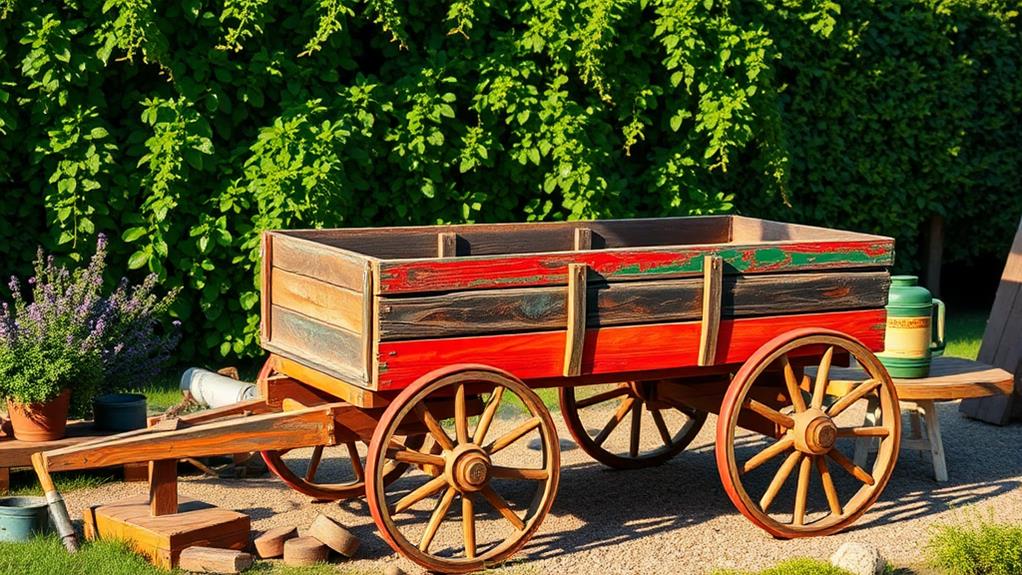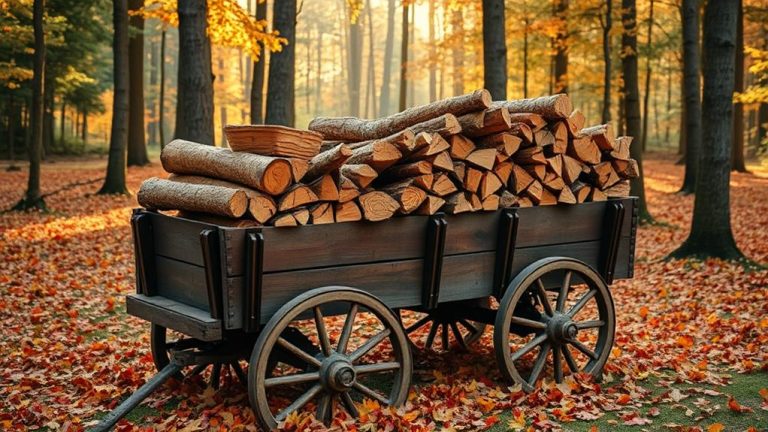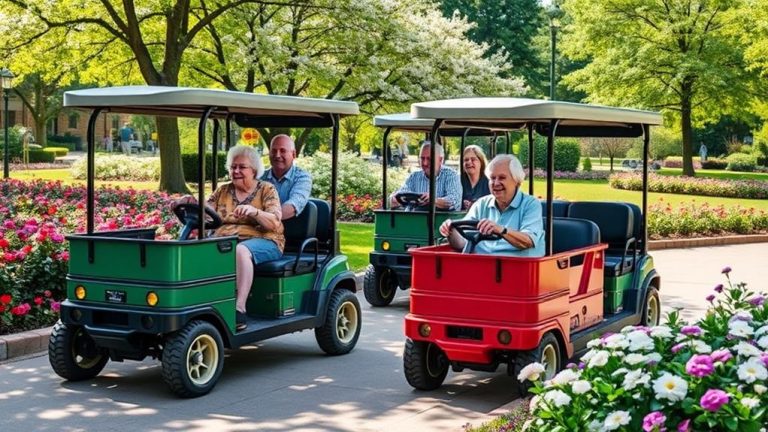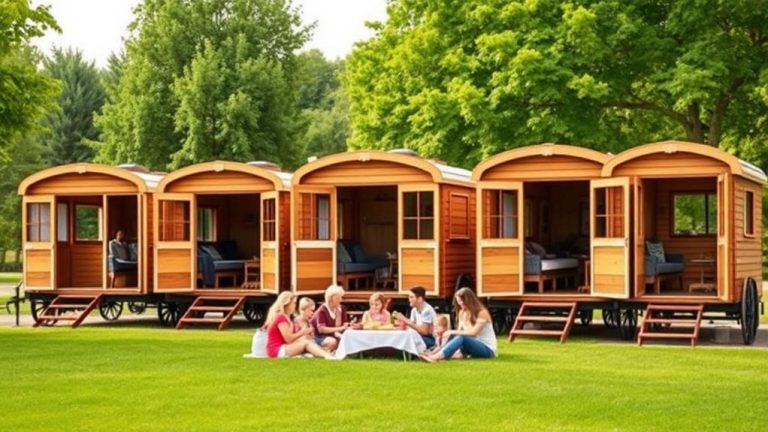To revive your antique wooden wagon, start by evaluating its condition; check for rot, decay, and structural weaknesses. Gather tools like hammers, screwdrivers, and an electric sander to aid your restoration. Clean the wood using a soft-bristle brush and a mild soap solution, then apply a wood conditioner for moisture. Repair any structural damage with wood glue or brackets, ensuring to replace any damaged wood with treated lumber. Finally, sand the surfaces and finish with a wood stain and protective coatings for longevity. You're just scratches away from uncovering its full potential, and there's more to discover as you proceed.
Assessing the Wagon's Condition
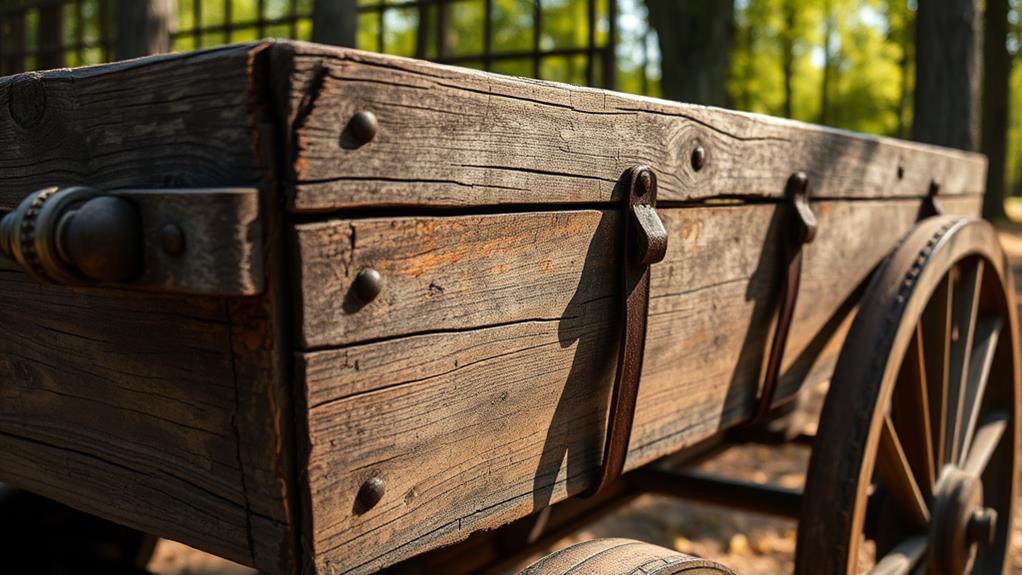
When you begin evaluating the wagon's condition, it's imperative to take a systematic approach. Start by examining the wooden frame for any signs of rot or decay, which could compromise the structural integrity. Pay close attention to joints and connections, as these areas often reveal the wear of time. The historical significance of your wagon lies not solely in its age but in its unique design styles, which reflect the craftsmanship of its era.
Inspect the wheels for cracks or warping; they're essential for both functionality and authenticity. If the wagon features any metal components, check for rust or corrosion, as these can detract from its aesthetic value. Document any repairs or modifications made over the years, as this history adds character and depth to your restoration efforts.
As you assess, think about how you can preserve the original design during enhancing its usability. This balance between maintaining historical significance and ensuring functionality is vital. With a sharp eye and a heart full of passion, you'll not only restore a beautiful piece of history but revive the spirit of freedom that antique wagons symbolize.
Gathering Necessary Tools
To commence your restoration voyage, gathering the right tools is essential for achieving a successful outcome. Your tool selection will greatly impact the efficiency and quality of your work. Start with a solid set of hand tools: a hammer, screwdrivers, pliers, and a measuring tape. These basics form the backbone of your toolkit. Furthermore, don't forget a good quality wood chisel and a pry bar; they'll come in handy for removing old nails and disassembling parts without damaging the wood.
You'll likewise want electric tools for larger tasks—an electric sander will save you time and provide a smooth finish, whereas a drill can assist with any new fittings. Remember, safety equipment is equally important. Invest in a sturdy pair of gloves to protect your hands from splinters and a dust mask to safeguard your lungs from wood particles.
Cleaning and Preparing the Wood
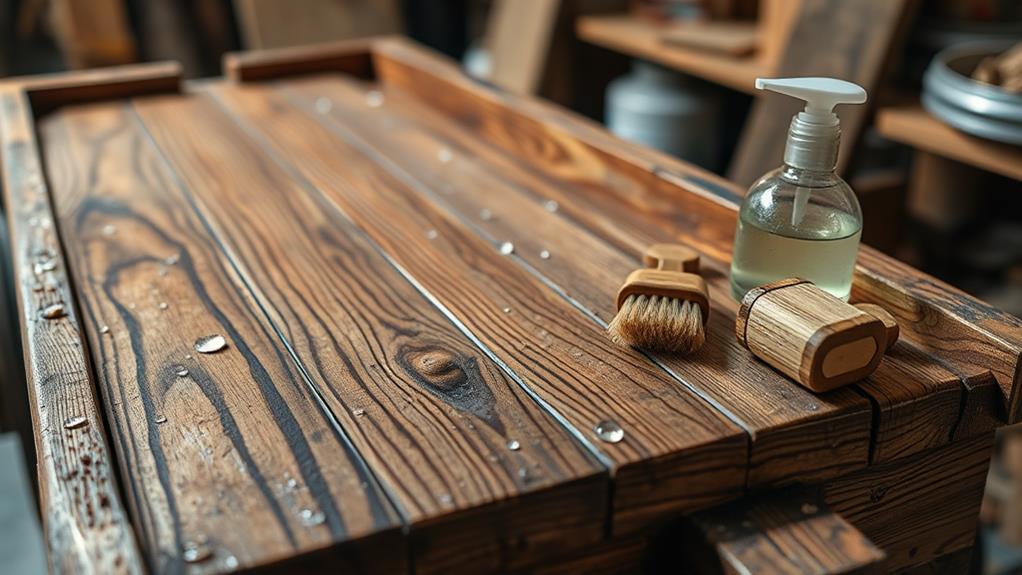
Your antique wooden wagon's beauty lies beneath layers of grime and age, so the first step in the restoration process is to thoroughly clean and prepare the wood. Start by identifying the wood types used in your wagon, as different woods may require specific cleaning solutions. For example, hardwoods like oak and maple can endure more vigorous cleaning methods than softer woods like pine.
Here's a simple list of items you'll need for this task:
- Soft-bristle brush – Perfect for gently removing dirt without scratching the surface.
- Mild soap solution – Mix water with a gentle soap to avoid damaging the wood's finish.
- Rags or microfiber cloths – Use these to wipe down surfaces and soak up excess moisture.
- Wood conditioner – After cleaning, this will help restore moisture and prepare the wood for any finishing treatments.
Gently scrub the wood with the brush and soapy solution, wiping away grime with your cloth. Rinse with clean water, ensuring no soap residue remains. Finally, allow the wood to dry completely before moving on to the next step. This preparation honors your wagon's history as it sets the stage for its revival.
Repairing Structural Damage
Evaluating and addressing structural damage is essential to guaranteeing your antique wooden wagon remains both functional and aesthetically pleasing. Start by inspecting joints, beams, and critical load-bearing areas. If you find weakened joints, consider joint reinforcement techniques, which can restore the integrity of the structure. Additionally, check for any signs of rot or insect damage that could compromise the wagon’s stability. If necessary, repair antique wagon axles by replacing damaged wood or reinforcing metal components to ensure smooth operation. Proper maintenance and timely repairs will help preserve the wagon’s historical value and functionality for years to come.
Repairing Structural Damage Steps
| Step | Description | Tools Needed |
|---|---|---|
| Inspect Joints | Check for cracks or gaps | Magnifying glass |
| Reinforce Joints | Use wood glue or brackets | Wood glue, brackets |
| Treat Wood | Apply protective wood treatment | Wood treatment solution |
| Replace Damaged Wood | Cut and fit new wood pieces | Saw, measuring tape |
For any damaged wood, be certain you replace it with treated lumber to prevent future rot. Applying a wood treatment before reassembly will help protect your wagon from environmental factors, guaranteeing its longevity. Remember, this isn't just about repair; it's about preserving a piece of history that deserves to be cherished. Taking these steps with care and precision will help you restore your wagon to its former glory, allowing it to roll freely once again on the paths of your memories.
Finishing Touches and Preservation
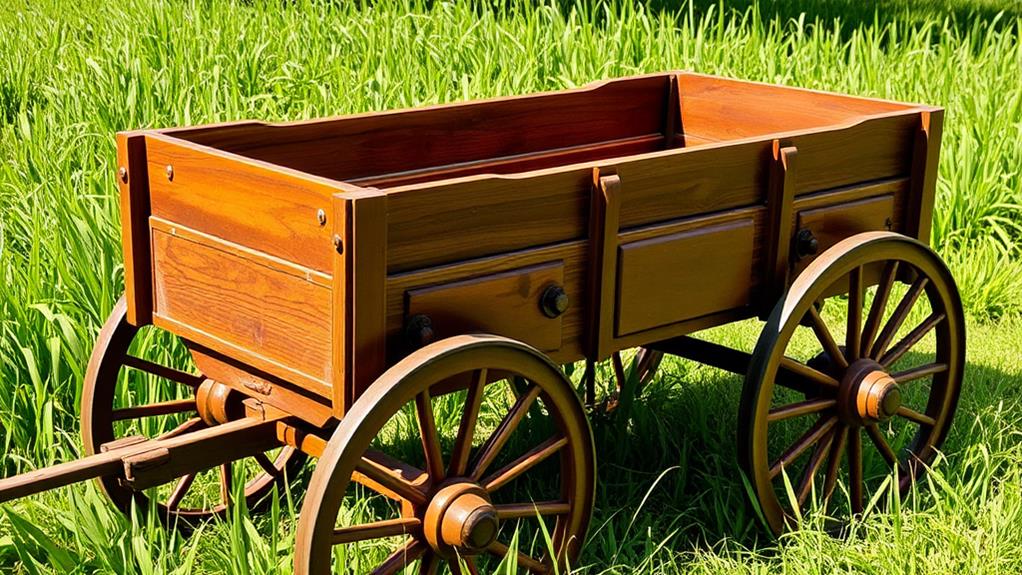
The final touches on an antique wooden wagon can transform it from a simple restoration project into a stunning work of art. To guarantee your wagon stands the test of time and showcases its beauty, consider these crucial finishing touches:
- Sanding: Smooth out any rough spots with fine-grit sandpaper, creating a flawless surface that feels just as good as it looks.
- Staining: Apply a rich, nourishing wood stain to improve the grain, giving your wagon a lively, warm tone that highlights its character.
- Protective Coatings: Finish with a high-quality protective coating, like polyurethane or marine varnish, to shield your masterpiece from moisture and UV rays, guaranteeing longevity.
- Detailing: Don't forget the small details; touch up any metal parts with rust-resistant paint and polish the wheels for that final gleam.
Incorporating these maintenance tips will not only boost the aesthetic but further preserve the integrity of your antique wagon. By embracing the beauty of your work, you celebrate freedom—freedom to create, restore, and cherish a piece of history that's uniquely yours.
Frequently Asked Questions
How Can I Determine the Age of My Antique Wooden Wagon?
To determine the age of your antique wooden wagon, think of it as unearthing a piece of history. Look for age indicators like construction methods, materials used, and any maker's marks. Research its historical context—what styles were popular during specific periods? Examine the wear patterns and patina; they tell tales of bygone adventures. This passion for discovery can lead you to appreciate not just the wagon's age, but the stories it carries.
What Type of Wood Is Commonly Used in Antique Wagons?
When restoring an antique wooden wagon, you'll often encounter wood types like oak, maple, and pine. Each has unique characteristics that affect durability and appearance. Using appropriate restoration techniques, like sanding and applying the right finishes, can improve the wood's natural beauty as well as preserving its integrity. Comprehending these wood types not just aids in restoration but additionally connects you with the craftsmanship of the past, allowing you to cherish your wagon's history.
Are There Specific Safety Precautions to Consider During Restoration?
When restoring antique items, you've gotta prioritize safety. Always wear protective gear like goggles and masks to guarantee you're shielded from dust and splinters. Tool safety is essential; use sharp, well-maintained tools to minimize accidents. Consider the workspace too—make sure it's well-ventilated to avoid inhaling harmful particles. By taking these precautions, you not just protect yourself but additionally preserve the integrity of your beautiful restoration project. Embrace the process with passion and care!
Can I Use Modern Paints or Finishes on Antique Wood?
You might think modern paints aren't suitable for antique wood, but that's not entirely true. Although some modern paint compatibility exists, it's essential to prioritize antique wood preservation. Using a high-quality primer can improve adhesion and protect the wood's integrity. Consider eco-friendly finishes that allow the wood to breathe, maintaining its character. Remember, it's about blending contemporary techniques with respect for the past, ensuring your restoration reflects both beauty and history.
Where Can I Find Replacement Parts for My Wagon?
When you're looking for replacement parts for your antique wagon, start by checking vintage wagon accessory shops online. Sites like Etsy or specialty restoration forums can connect you with passionate collectors who might have what you need. Don't overlook local antique shops or flea markets, either; they often have hidden gems. Remember, each piece you find contributes to your antique wagon restoration expedition, bringing it back to life with authenticity and charm.

